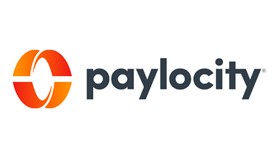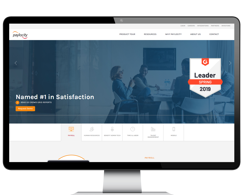
Industry-leading cloud-based payroll and human capital management provider Paylocity needed a website overhaul to align with their rebrand and resolve ongoing usability challenges. Marcel Digital approached this project with a data-driven strategy, ensuring every decision - from UX design to SEO migration - was focused on enhancing visibility, streamlining the user journey, and empowering Paylocity’s marketing and sales teams.
Why Did We Start the Project?
The Challenge
Paylocity partnered with Marcel Digital to build a website that not only showcased their new brand identity but also improved overall usability and performance. Key stakeholders outlined several critical pain points:
- Difficult navigation, making it hard for prospects to find relevant content
- Complex content management system (CMS), slowing down updates
- Slow page load times, impacting user engagement and SEO
- A disconnect between brand messaging and website experience
- Low mobile engagement, limiting reach to decision-makers on the go
Beyond design and functionality, Paylocity needed to retain and improve their organic search rankings post-migration. This meant an in-depth SEO migration strategy was crucial to protecting their digital presence and ensuring continued inbound lead generation.
The biggest challenge? Delivering all of this on a tight timeline with multiple stakeholders and moving parts, requiring seamless collaboration and execution.

What’s Going On?
The Analysis
Our approach was built on collaboration and data. Marcel Digital’s UX and web development teams engaged in regular strategy sessions with Paylocity stakeholders to align on goals, gather insights, and refine priorities. The goal was to build a website that not only looked great but actively supported lead generation and sales enablement.
Speak to the Rebrand
With a new brand identity in place, it was critical that Paylocity’s website reflected their updated positioning. Every element - logos, colors, layouts, typography - needed to align with the refreshed brand guidelines.
Marcel Digital worked closely with Paylocity’s marketing and branding teams to ensure the website effectively communicated their value proposition while maintaining a cohesive brand experience across every touchpoint.
Focus on User Experience
Understanding how users interacted with the previous website was key to creating an experience that would drive conversions. Using tools like Hotjar, we conducted in-depth UX research to optimize user flows and content placement:
- Heatmaps & Clickmaps: Identified areas of high engagement and friction
- Scrollmaps: Determined where users dropped off
- User Videos & Surveys: Collected direct feedback to address usability concerns
This data allowed us to refine site navigation, streamline content, and optimize calls to action, ensuring that prospects and customers could easily find the information they needed.
Maintain SEO Visibility
A website overhaul without an SEO strategy can be catastrophic for organic traffic. Our SEO team conducted a thorough audit to ensure Paylocity maintained - if not improved - their search visibility post-launch.
Using tools like Google Analytics, SEMRush, and Majestic, we analyzed:
- High-value pages driving conversions and lead generation
- Keyword rankings and backlink profiles
- Content gaps presenting new SEO opportunities
By developing a robust 301 redirect strategy and refining on-page SEO elements, we ensured Paylocity’s website retained its authority and continued to attract qualified traffic.
Keep the Data Clear
Accurate data is essential for measuring success and making informed marketing decisions. Our Google Analytics team conducted a full audit and migration, ensuring Paylocity had the insights needed to track conversions, measure engagement, and optimize future strategies.
From refining event tracking to building custom dashboards, we empowered Paylocity’s marketing team with real-time data on site performance and user behavior.



How Did Marcel Digital Help?
The Solution
With research in place, we executed the website rebuild across four key areas:
Data-Driven Information Architecture
We restructured Paylocity’s site navigation based on insights from Google Analytics and stakeholder feedback. Our goal was to align content with the needs of Paylocity’s Ideal Customer Profile (ICP) while optimizing user flow for conversion. The navigation was structured around:
- Who We Serve - Targeting personas and business sizes Paylocity supports
- Our Products - Highlighting solutions that streamline HR and payroll processes
- Resources - Providing educational content for prospects and customers
- Who We Are - Showcasing Paylocity’s company and culture
- Careers - Attracting top talent to their growing team
By aligning site structure with audience intent, we improved usability and strengthened SEO performance.
Brand-Focused Designs
While Marcel Digital didn’t handle the full design process, we played a crucial role in shaping the UX foundation. We worked closely with Paylocity’s branding and design teams to ensure the final website met three key objectives:
- Brand Alignment: Every element adhered to the new brand guidelines
- User-Centric Simplicity: Intuitive navigation and clear CTAs
- Mobile Optimization: Ensuring accessibility across all devices
This collaborative approach ensured a seamless transition from wireframes to final designs, keeping all stakeholders aligned throughout the process.
Seamless Analytics Migration
Our analytics team conducted a full migration to Google 360, ensuring accurate tracking of key performance metrics. We:
- Audited existing GA implementations for data integrity
- Created custom event tracking to measure user engagement
- Built dashboards for real-time performance monitoring
The result? A streamlined analytics setup that provides Paylocity with deep insights into site performance, lead generation, and conversion trends.
Highly Focused SEO Migration
To protect and enhance Paylocity’s organic search presence, our SEO team executed a comprehensive migration plan. This included:
- Full Content Analysis: Prioritizing pages based on SEO value and lead generation potential
- Redirect Mapping: Ensuring a seamless transition from old to new URLs
- Content Optimization: Updating and consolidating key pages to enhance rankings
By taking a meticulous approach to SEO, we not only safeguarded Paylocity’s search visibility but also positioned them for future growth in organic traffic.



What Happened After Launch?
The Results
The impact of Paylocity’s new website was immediate and measurable. Within three months post-launch, they experienced:
- 43% increase in organic traffic
- Higher engagement rates due to improved UX and streamlined content
- Stronger lead generation performance with better-optimized conversion paths
The new website is more than just a digital refresh - it’s a powerful marketing and sales enablement tool that continues to drive measurable business impact.
Our collaboration with Paylocity didn’t end at launch. Our SEO and analytics teams continue to provide strategic insights, helping them capitalize on opportunities for ongoing growth and digital transformation.

Ready to start your project?
Our team would love the opportunity to hear more about your needs. Fill out the form, and we'll reach out to you shortly.